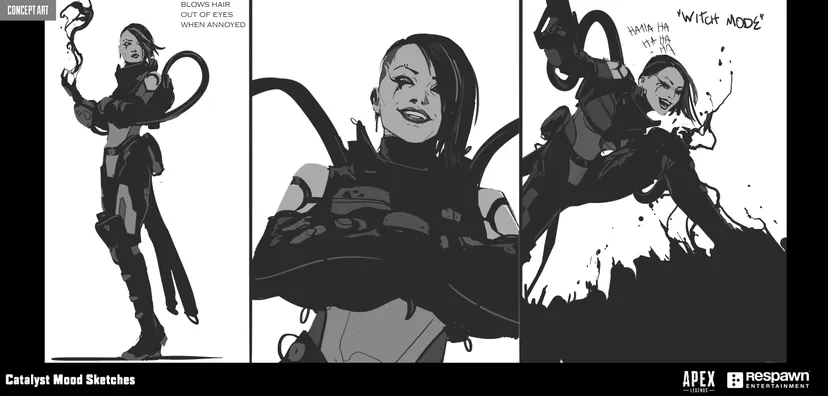Why Apex Legends went loud and happy with trans legend Catalyst
A brand-new playable character for Pinnacle Legends, Catalyst, was unveiled by Respawn Entertainment in late 2022.Driver entered the battle royale with a whole new terrain and a witchy playstyle focused on ferrofluid metal control.
She is also one of the first transgender women to appear in a commercial multiplayer video game and the first transgender woman in the game’s cast. When Respawn first revealed her to the public, she was not vague about her gender identity. In their first promotion, they told players that she was transsexual. Her primary character’s artwork is in the transgender flag’s colours. Her opening cinematic makes reference to the most recent gender-affirming surgery.
And Catalyst is outspoken and ecstatic about her identity in the video game. With phrases like “I am the grim trans witch your moms and dads alerted you about,” this defensive-minded legend isn’t guarded about her identity.
The decision by Respawn to introduce a brand-new transgender legend was not made in a vacuum. The cycle of driver advancement coincided with an upsurge in the legal and physical harassment of transgender people in the US, the UK, and other countries. The character may have been dropped by the video game developer in an effort to avoid the wrath of an angry retaliatory action. Her parents were chosen by Driver’s developers.
Designers must decide how to create and feature characters from the LGBT+ community in an era of such extreme intolerance. With Pride Month coming to an end, the main author of Pinnacle Legends Ashley Reed, character artist Mirim Lee, and voice actress Meli Grant joined us to discuss the sources of inspiration for Catalyst’s look and personality as well as to discuss what else designers can do for employees and players during these trying times.
There’s no hiding who Catalyst is
The impulse to introduce Catalyst, according to Reed, came from the same mentality that gave rise to the other members of the Peak Legends group. We have always assumed that since this video game takes place in a time after our own, it must depict the same world that we do. Therefore, the experiences of our [team] have inspired the characters we have created.
That meant the lives of transgender women at Respawn were the fabric from which Catalyst was sewn (along with some evaluation from GLAAD). Given that she was reared in an environment without direct contact to trans people, Lee claimed that working with trans designers and experts on a trans character helped her learn more about her coworkers. She admitted that she had learned a lot of new information and felt rather embarrassed about it.

Grant claimed that after learning that Respawn was looking for a trans superstar, she became “consumed” with the idea of getting the job of Catalyst. She said, describing how comfortable Catalyst was, how much of herself she recognised in the local witch. These are the riskiest positions because, in most cases, you won’t get the ones you seem to have the best chance of getting.
That kind of passion is what drives Catalyst’s explosive energy. Outside the arena, she frequently riffs on magic, the moon, and her friends. Respawn hasn’t shied away from having any of its LGBT characters come out in-game. When players “thank” each other, other characters involved in sexual relationships may chitchat and flirt, and Catalyst has a number of voice lines that, for lack of a better term, are about being a trans woman.
As another example of something that came about through dealing with her transgender employees, Reed cited a phrase in which Catalyst is making fun of her ferrofluid-themed abilities: “If you can’t produce your own liquid metals, store-bought is great,” she will occasionally say.
The driver’s line refers to a joke that parodies the famous line of chef Ina Gartner, “Store-bought is fine.” The meme—which at first made reference to “summoning flames from hell”—evolved into a transgender inside joke along the lines of, “If you can’t make your own oestrogen, store-bought is great.”
Reed argued that phrases like that demonstrated the Peak team’s intention to have Catalyst interact with players in a sincere manner. “We wanted to include sentences that made it look as though we weren’t addressing the audience, as if we were educating them about what it means to be trans. We wanted to speak with any trans people there.
She emphasised that if she were a cisgender woman, she would not have known to take that line out of her hat, and it was only because of her friends (and some input from Grant) that they were able to include such realistic suggestions.
While the inspiration for Catalyst came from a real-life trans experience, Reed noted that there was another important reason for including lines like this: when Apex previously featured LGBT characters, some players were prepared to ignore, downplay, or reject that aspect of their identity.

When we’ve been more tactful about it, we’ve seen people willing to hide [certain information], Reed recalled. She was mostly making reference to the nonbinary Pinnacle Legends character Bloodhound, a helmeted hunter whose past has previously been highlighted but who more frequently speaks of spilling blood and honouring the Allfather.
Even though we’ve said Bloodhound is nonbinary, there is still a lot of debate around their identification, Reed lamented. ‘There’s no argument!’ we say. You’re arguing, why?
Long-term designers might find this to be a well-known tale. LGBT characters were frequently left out of the marketing of mainstream video games until perhaps the last five years, or they were put in a tight spot when material was sent to countries like China and Russia (where depictions of LGBT characters are more strictly regulated or outlawed).
According to Reed, the way Catalyst was portrayed ruled out the prospect of it happening.
Trans individuals require real-world representation too
While the majority of our conversation centred on Catalyst, Grant drew attention to a crucial nearby issue: while it’s great that Respawn and other designers are expanding transgender representation in their video games, doing so is only partially as important as supporting trans designers in the real world.
She added that it was equally important to show the talent and creative minds behind the characters who also belonged to those communities. As nice as it is to see a character who resembles you on a dream book page or in a video game, it’s just as important to see actual people who resemble you succeeding in the real world. that you see there is more to life than what you see on TV or on your computer, that there is a place for you in this world.

Grant was able to contextualise such feelings in light of her own professional experience. “Even if there is an animated character, I can’t [understand] what it means to be a trans star operating in programme organisation. That does not instruct me in any way.
But I think it’s really beneficial to see a genuine person doing it and to be able to share those experiences and demonstrate that it’s feasible.
Grant has actually become more approachable to fans after the release of Catalyst. Through her Twitch livestream, she has connected with people who have either played Catalyst and discovered something about themselves or who have used Catalyst to explain their trans identity to close friends or family members.
Although a ferrofluid-wielding trans witch from the stars can be a great metaphor for gamers, Grant’s thoughts immediately turn to the real people who gave her existence. Designers can do real good by promoting the work of trans workers and demonstrating that their groups are ones where they may thrive in a time when some forces want to eradicate transgender people from existence.

























